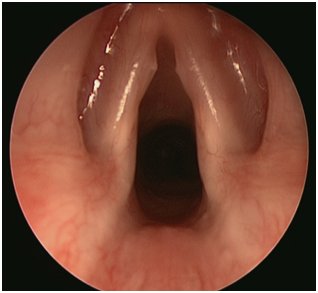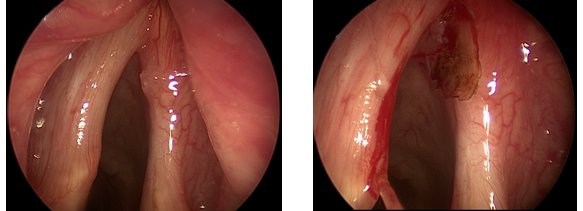Treatment of Voice Disorders
From Khalid Ghufoor FRCS
The vast majority of people who suffer a change in voice or hoarseness will have a self limiting short lasting problem usually related to a viral infection. Occasionally the voice can remain poor due to other factors such as bacterial infections leading to pain on speaking, fever and feeling unwell. Fortunately such symptoms respond well to antibiotic, voice rest and steam inhalations.
Chronic voice disorder has many causes, the most commonest is related to voice misuse, leading to vocal nodules.

Vocal nodules, swelling the middle part of the vocal cords (folds)
The treatment of this problem involves a careful assessment to identify factors that are leading to vocal strain such as raising the voice, shouting, cough or throat clearing and counseling against such harmful behaviour. Accurate evaluation of the larynx by endoscopic view during voice use with a specialised stroboscopic light enables a highly magnified and slowed down view of the vocal fold lining. Polyps tumours and nodules can be distinguished as a result of this videolaryngostroboscopic technique. Simple vocal nodules respond well to speech therapy techniques which relax the vocal tract and prevent misuse.
Less common causes for voice change include laryngeal cancer which is amenable to treatment by standard radiotherapy techniques or by laser surgery which has been shown in many studies to have excellent cure rates 1,2.

Laryngeal cancer, (left image) swelling of the right vocal cord, which was successfully cured by laser surgery (right image)
1: Management of early glottis cancer : Cummings Otolaryngology: head and neck surgery (book) 2010 page101-104
CW Cummings, PW Flint, T Phelps, WM Abuzeid
2: Higher laryngeal preservation rate after CO2 laser surgery compared with radiotherapy in T1a glottic laryngeal carcinoma
Head & Neck Volume 31, Issue 6, pages 759–764, June 2009
M L. Schrijvers, E L. van Riel, J A. Langendijk, F G. Dikkers, E Schuuring, J E. van der Wal, B.F. A. M. van der Laan .
